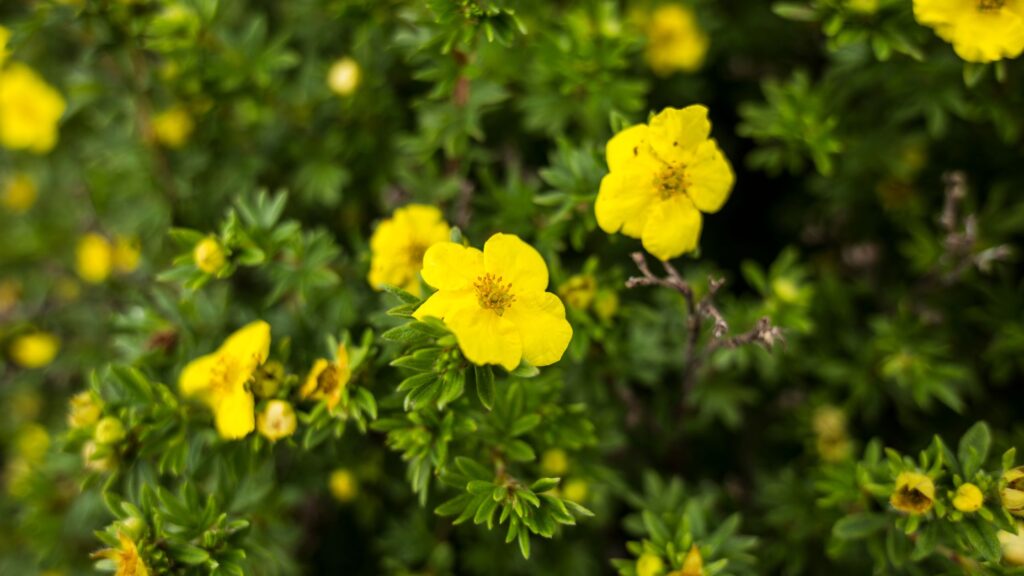Potentilla plant
Potentilla, also known as shrubby cinquefoil or bush cinquefoil, is a delightful landscape shrub valued for its long bloom time, exceptional hardiness, and carefree nature. It belongs to the genus Potentilla fruticosa. Flower hues include orange, pink, red, and white. The foliage can be blue-green or chartreuse/gold.

Potentilla Varieties
- Shrubby Potentilla
- Potentilla nepalensis
- Potentilla recta
- Potentilla aurea
- Potentilla atrosanguinea
Potentilla CARE TIPS
Here are some care tips for your Potentilla plants:
Planting
- Potentilla grows best in the milder months of spring and fall. Spring is generally preferred to allow the roots to establish themselves before winter.
- Choose a site that receives full sunlight to moderate shade. They will tolerate some shade, especially in hot climates, but full sun will encourage more flowering.
- Potentilla prefers well-draining soil. If your soil is heavy clay, you can amend it with compost or sand to improve drainage.
- Dig a hole that is 1-1/2 times larger than the root ball of your Potentilla.
- Gently tease out the roots of your Potentilla if it is pot-bound.
- Place the Potentilla in the hole so that the top of the root ball is level with the soil surface.
- Backfill the hole with earth and water well.
Watering
- Water your Potentilla regularly during the first growing season to encourage deep root growth.
- Once established, Potentilla is drought tolerant and can withstand periods of dry weather.
- However, it will flower best if you water it deeply during hot, dry spells.
- Avoid overwatering, since it might lead to root rot.
Fertilizing
- Potentilla does not require a lot of fertilizer. A small dose of balanced fertilizer in early spring is adequate.
- You can also mulch around your Potentilla with compost or other organic matter to help retain moisture and nutrients.
Pruning
- Potentilla requires minimal pruning. However, you can prune it lightly in early spring to remove any dead or diseased wood.
- You can also prune your Potentilla after it has finished flowering to shape it and encourage new growth.
- If your Potentilla becomes overgrown, you can give it a harder prune in late winter or early spring. Cut the stems back by approximately a third.
Pests and Diseases
- Potentilla is generally resistant to pests and diseases. However, they can occasionally be bothered by aphids, scale, and powdery mildew.
- If you see any pests or diseases on your Potentilla, you can treat them with insecticidal soap or neem oil.
Deadheading
- Deadheading refers to the process of removing spent blooms from your plants. This will encourage your Potentilla to produce more flowers.
- You can simply deadhead your Potentilla by pinching off the spent flowers with your fingers.
Potentilla shrub
Here’s a quick care guide for your Potentilla shrub:
- Planting: Plant Potentilla shrubs in spring or fall in a location that gets full sun to partial shade. They prefer well-draining soil.
- Watering: Water your Potentilla shrub regularly during the first growing season, then they are drought tolerant once established.
- Fertilizing: Potentilla shrubs don’t require a lot of fertilizer, but a light application of a balanced fertilizer in early spring is sufficient.
- Pruning: Prune Potentilla shrubs lightly in early spring to remove dead or diseased wood. You can also prune them after flowering to shape the plant and encourage new growth.
Potentilla Goldfinger
The Potentilla fruticosa ‘Goldfinger’, also known as Shrubby Cinquefoil ‘Goldfinger’, is a vibrant and hardy flowering shrub. Here are some details about this delightful plant:
- Appearance: It boasts masses of large, rich yellow flowers, each about 1.5 inches across (4 cm), from late spring to the first frost. The flowers are so abundant that they literally cover the plant. These bright yellow flowers contrast beautifully against the foliage mound of small, pinnate, dark green leaves.
- Long Blooming Season: Noted for its extremely long blooming season, Shrubby Cinquefoil is an incredibly tough plant. It can withstand drought in the summer as well as cold temperatures in winter.
- Easy Care: This first-class shrub is perfect for informal hedging or sunny borders. It grows up to 2-3 feet tall (60-90 cm) and 3-4 feet wide (90-120 cm). Shrubby Cinquefoil performs best in full sun or part shade, in average, medium moisture, well-drained soils. It’s not fussy about soil types as long as they are well-drained. Additionally, it tolerates drought, salt, and poor soils.
- Pest and Disease Resistant: Virtually pest and disease-free, it is also deer-resistant.
- Uses: Shrubby Cinquefoil is very adaptable and an excellent choice as a single specimen plant, massed in beds and borders, or as an informal hedge. After flowering, trim it lightly by cutting out some of the oldest stems to make room for new growth.
- Propagation: You can propagate it by softwood cuttings in early summer


